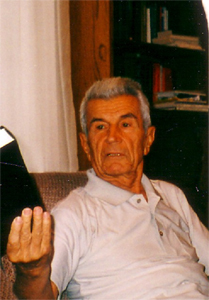Professor Dr. Roman Vlaicu and the discovery of inflammation in atherosclerosis
 Professor Dr. Roman Vlaicu, a member of the Romanian Academy of Medical Sciences and Chairman of the Department of Internal Medicine at Medical Clinic No.1 in Cluj-Napoca from 1975 until 1992, died on December 3, 2010, at the age of 83. He left us, his disciples in clinical internal medicine and researchers in the mechanisms of atherosclerosis, with memories of vibrant times and of his apparently endless enthusiasm for the future of medical research and its benefits for human health. Roman Vlaicu maintained his belief in the true value of human beings and their fundamental right to liberty, even in the face of an environment in which a profound dissolution of basic social structures had occurred at the hands of a brutal and totalitarian “Red” communist regime.
Professor Dr. Roman Vlaicu, a member of the Romanian Academy of Medical Sciences and Chairman of the Department of Internal Medicine at Medical Clinic No.1 in Cluj-Napoca from 1975 until 1992, died on December 3, 2010, at the age of 83. He left us, his disciples in clinical internal medicine and researchers in the mechanisms of atherosclerosis, with memories of vibrant times and of his apparently endless enthusiasm for the future of medical research and its benefits for human health. Roman Vlaicu maintained his belief in the true value of human beings and their fundamental right to liberty, even in the face of an environment in which a profound dissolution of basic social structures had occurred at the hands of a brutal and totalitarian “Red” communist regime.
Professor Dr. Roman Vlaicu was born to a humble family in a mountain village of Romania; after the untimely death of his parents when he was quite young, he was raised and educated by a series of foster families. Despite the challenges of his early life, he graduated from the famous Saint Sava College in Bucharest, and then from the Medical School in Cluj-Napoca, where he practiced internal medicine until his retirement. Early in his professional life he survived two open-heart surgeries and both times returned to his clinic with his characteristic calm smile. He was a truly accomplished Renaissance man and a true teacher, one of the very last in Romania to establish a productive, continuing medical school tradition of teaching internal medicine and conducting research in this medical field. It was very common for us acknowledge at that time that “all I know and practice in internal medicine is from Vlaicu’s teaching!”
Between 1980 and 1990, before we left our country, Professor Vlaicu underwent a Sisyphean struggle to protect our work, build new laboratories, establish new collaborations, and obtain the basic research tools necessary to pursue and push forward our ideas, especially the concept of inflammatory events associated with the progression of atherosclerotic plaques. He first presented our data on immunolglobulins and complement component localization in human atherosclerotic plaques at the Moscow World Congress of Cardiology in December 1981, and he was the one who presented to the international medical community (at the World Congress of Cardiology in Dusseldorf, July 1985) our data regarding the deposition of C5b-9 complexes in the atherosclerotic wall, which provided clear evidence for local complement activation and for the role of inflammatory processes in arterial tissue damage. He never pushed himself in front of the team who had generated these data, and he always acknowledged the team as essential to his lab’s major accomplishments. After we left his clinic for better-funded and stronger research teams in the US, he was always proud and happy to have us visit and share our new data with our Romanian colleagues.
Roman Vlaicu lived a happy and fruitful life. He was beloved by many and hated by the communist regime, but at the same time never ignored. Despite the harsh social and political conditions under which he lived, his candor, persistence, and courage allowed him to prevail. He built a clinical and medical research tradition that is still alive today despite his inevitable departure. I will always fondly remember my struggle to be in his office early in the morning, before 7 AM when nobody was around, in order to have a couple of minutes together to chat and to plan.
Florin Niculescu MD, PhD
Horea Rus MD, PhD
Baltimore, March 2011